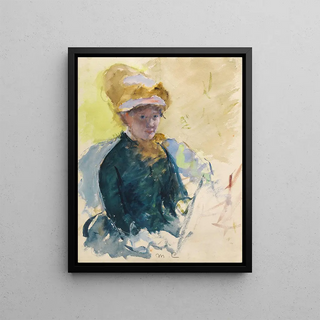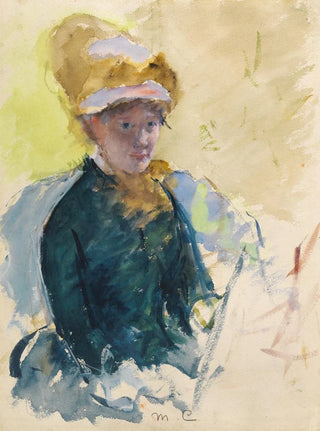Art print | Self-portrait - Mary Cassatt


View from behind

Frame (optional)
Mary Cassatt Self-Portrait – Engaging Introduction
Art is a mirror that reflects not only reality but also the soul of the artist. From this perspective, Mary Cassatt's self-portrait stands out as an iconic work that transcends mere representation. By choosing herself as the subject, Cassatt invites us to delve into her intimate universe, where emotions, reflections, and aspirations intertwine. This piece, both personal and universal, offers a window into the life of a woman artist at a time when the art world was largely dominated by men. Through this portrait, she does not merely depict herself; she asserts her presence and her role as an artist in a milieu that was often hostile to her.
Style and uniqueness of the work
Mary Cassatt's self-portrait is distinguished by its unique style, blending an impressionist sensitivity with undeniable technical mastery. The brushstrokes, both lively and delicate, capture light and shadow with remarkable finesse. Cassatt skillfully plays with colors to create an atmosphere imbued with softness and intimacy. Her gaze, both contemplative and determined, challenges us and prompts us to question our own perception of art and femininity. The choice of motifs and the composition of the work reflect her desire to assert herself in a rapidly changing artistic landscape. By depicting herself, she is not content to be a passive subject; she becomes an active participant in her own story, a woman claiming her place in art history.
The artist and her influence
Mary Cassatt, born in 1844, is one of the leading figures of Impressionism, an artistic movement that revolutionized the way we perceive and depict the world. Through her works, she captured daily life of women, their intimacy, their joys, and their sorrows. Her influence extends far beyond her time, inspiring many contemporary artists who see in her a model of courage and determination. Cassatt also played a crucial role in promoting women’s art, exhibiting alongside great masters such as Degas and Monet. Her self-portrait is a

Matte finish

View from behind

Frame (optional)
Mary Cassatt Self-Portrait – Engaging Introduction
Art is a mirror that reflects not only reality but also the soul of the artist. From this perspective, Mary Cassatt's self-portrait stands out as an iconic work that transcends mere representation. By choosing herself as the subject, Cassatt invites us to delve into her intimate universe, where emotions, reflections, and aspirations intertwine. This piece, both personal and universal, offers a window into the life of a woman artist at a time when the art world was largely dominated by men. Through this portrait, she does not merely depict herself; she asserts her presence and her role as an artist in a milieu that was often hostile to her.
Style and uniqueness of the work
Mary Cassatt's self-portrait is distinguished by its unique style, blending an impressionist sensitivity with undeniable technical mastery. The brushstrokes, both lively and delicate, capture light and shadow with remarkable finesse. Cassatt skillfully plays with colors to create an atmosphere imbued with softness and intimacy. Her gaze, both contemplative and determined, challenges us and prompts us to question our own perception of art and femininity. The choice of motifs and the composition of the work reflect her desire to assert herself in a rapidly changing artistic landscape. By depicting herself, she is not content to be a passive subject; she becomes an active participant in her own story, a woman claiming her place in art history.
The artist and her influence
Mary Cassatt, born in 1844, is one of the leading figures of Impressionism, an artistic movement that revolutionized the way we perceive and depict the world. Through her works, she captured daily life of women, their intimacy, their joys, and their sorrows. Her influence extends far beyond her time, inspiring many contemporary artists who see in her a model of courage and determination. Cassatt also played a crucial role in promoting women’s art, exhibiting alongside great masters such as Degas and Monet. Her self-portrait is a






